The beefsteak mushroom (other common name: ox tongue fungus), scientifically known as Fistulina hepatica, is a unique and distinctive edible mushroom species known for its appearance and its tendency to resemble cooked meat, particularly beef.
Beefsteak polypore fungi can be found in various parts of North America, Europe, and Asia, although they are more prevalent in temperate regions.
How To Identify A Beefsteak Fungus?
Identifying beefsteak mushrooms (Fistulina hepatica) in the wild requires careful observation of their physical characteristics.
Here’s a step-by-step guide to help you identify these wild mushrooms:
What Are You Foraging For Right Now?
We're thrilled to hear your ideas. What would you like to submit today? Feel free to share your thoughts and experiences with us.
Location and Habitat:
- Beefsteak mushrooms are typically found growing on the trunks and stumps of hardwood trees, such as beech and oak trees.
- They are most commonly seen in temperate regions, usually from late summer to early fall.
Size and Shape:
- Beefsteak mushrooms can be quite large, with caps ranging from 4 to 12 inches (10 to 30 cm) or more in diameter.
- The cap is generally flat and often irregularly shaped, with a wavy or lobed margin.
Color and Texture:
- Young beefsteak mushrooms have a vibrant, reddish-orange to reddish-brown color.
- The surface of the cap is often wrinkled, puckered, or veined, resembling the texture of cooked meat.
- The flesh is thick, soft, and fleshy, similar to the texture of meat.
Underside:
- One of the key identifying features of beefsteak mushrooms is the porous, sponge-like underside of the cap.
- The underside is made up of small, irregular pores that are initially white but may turn brown or pinkish with age.
Spore Print:
- To confirm the identification of beefsteak mushrooms, you can take a spore print. Place the cap, pore-side down, on a piece of white paper overnight. The spore print of beefsteak mushrooms is usually brown or brownish-red.
Odor:
- The odor of fresh beefsteak mushrooms is often described as fruity or sweet.
Changes with Age:
- They become tougher, develop a more acidic taste, and may turn darker in color, ranging from brown rot to nearly black.


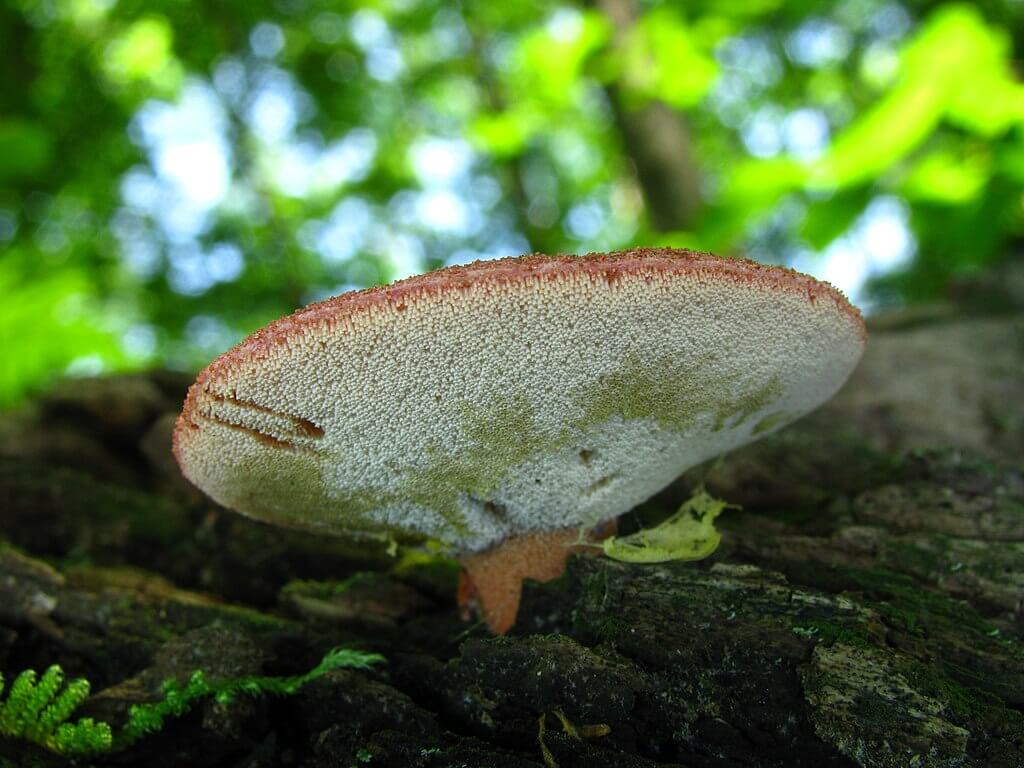
Is the beefsteak mushroom edible?
Yes, the beefsteak mushroom is considered edible.
Beefsteak mushrooms should be eaten when they are relatively young and still have a soft, fleshy texture. As they age, they become tougher and develop a more acidic taste, which can make them less desirable for culinary use.
Can you eat beefsteak fungus raw?
While young and tender beefsteak mushrooms are considered edible raw, it is generally recommended to cook them first.
The primary reason is that raw beefsteak mushrooms can have a somewhat sour or acidic taste that may not be pleasant to many palates.
What does a beefsteak mushroom taste like?
The taste of beefsteak mushrooms is somewhat unique in the mushroom world due to their tangy and slightly sour notes when young and their savory, meaty quality when cooked.
Their distinctive flavor profile makes them a great ingredient for experimenting in the kitchen.
Does beefsteak fungus taste like beef?
Beefsteak fungus does not taste like beef, despite its name and the fact that it is sometimes referred to as “beefsteak mushroom” due to its appearance.
While it does have some meaty qualities in terms of texture, its flavor is quite distinct from beef.
Foraging for Beefsteak Mushrooms
Where to forage for beefsteak mushrooms:
Beefsteak mushrooms are typically found in hardwood forests, often growing on the trunks and stumps of hardwood trees, especially oak and beech.
Here are some general regions and states to go mushroom foraging for beefsteak boletus:
- Eastern United States:
- Beefsteak mushrooms are relatively common in the eastern United States, especially in deciduous forests with oak and beech trees.
- States like New York, Pennsylvania, Ohio, West Virginia, Kentucky, Virginia, North Carolina, and Tennessee have reported sightings of beefsteak mushrooms.
- Midwestern United States:
- In the Midwest, you may find beefsteak mushrooms in states like Michigan, Wisconsin, and Illinois, particularly in areas with hardwood forests.
- Southern United States:
- In the southern states, including Georgia, Alabama, Mississippi, Louisiana, and Arkansas, beefsteak mushrooms can be found in suitable forested habitats.
- Northeastern United States:
- States in the northeastern region, such as Vermont, New Hampshire, and Maine, also have suitable habitats for beefsteak mushrooms.
When to forage for beefsteak mushrooms:
- Late Summer to Early Fall: In many regions of North America, beefsteak mushrooms are most commonly found during the late summer and early fall months. This period usually spans from August through October.
- Temperature and Rainfall: Beefsteak mushrooms tend to fruit when there is sufficient moisture and the temperature is favorable. Rainfall and humidity play a significant role in their fruiting. A period of rain followed by warm weather can trigger their growth.
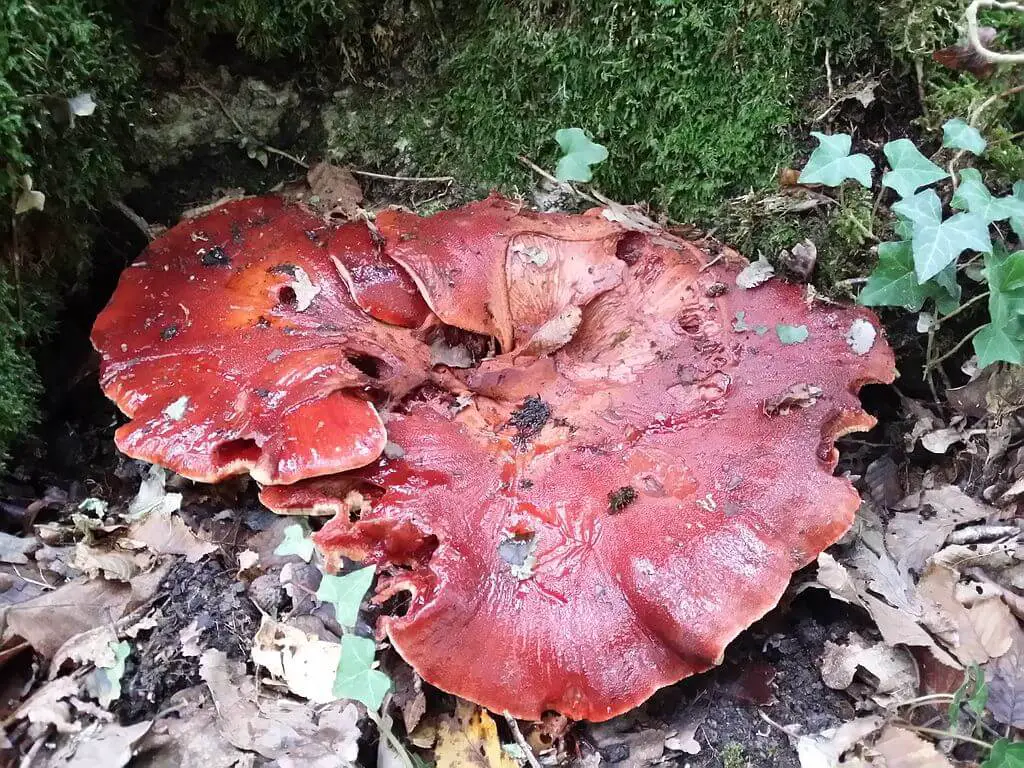
Any Look-Alikes?
Beefsteak mushrooms have a unique appearance, but there are some other fungi and mushrooms that can be mistaken for them, especially when it comes to texture and color.
It’s crucial to be able to differentiate between beefsteak mushrooms and potential lookalikes to ensure safe foraging.
Here are some common lookalikes to be aware of:
False Turkey Tail (Stereum ostrea) – inedible
- The false turkey tail is one of the most common lookalikes for beefsteak mushrooms.
- It has a similar flat, bracket-like growth form and can be reddish-orange like beefsteak mushrooms.
- Unlike beefsteak mushrooms, false turkey tail lacks pores on the underside and has a smooth, crust-like surface.
Ganoderma Species – too tough to eat
- Some species of Ganoderma mushrooms, such as the Ganoderma applanatum, can resemble beefsteak mushrooms, especially when older and with a smoother, reddish-brown surface.
- Ganoderma mushrooms are often found on the trunks of hardwood trees and have a similar bracket-like growth.
- Unlike beefsteak mushrooms, Ganoderma species have a distinct glossy surface and a more woody texture.
Hapalopilus nidulans – inedible
- Hapalopilus nidulans is another bracket fungus that can be mistaken for beefsteak mushrooms.
- It has a reddish-brown to orange-brown cap with a similar bracket-like growth form.
- The underside of Hapalopilus nidulans has a maze-like or labyrinthine structure of pores, which distinguishes it from beefsteak mushrooms.
- Hapalopilus nidulans is not generally considered edible.
Fomitopsis pinicola (Red-Belted Polypore) – too tough to eat
- This fungus can appear similar to beefsteak mushrooms due to its bracket-like growth and reddish-brown cap.
- The underside of Fomitopsis pinicola has pores, but they are typically smaller and denser than those of beefsteak mushrooms.
Pycnoporus cinnabarinus (Cinnabar Polypore) – inedible
- This bright orange or red-orange mushroom may resemble beefsteak mushrooms in color but typically has a more irregular shape.
- The underside of Pycnoporus cinnabarinus has fine pores and may not have the same texture as beefsteak mushrooms.
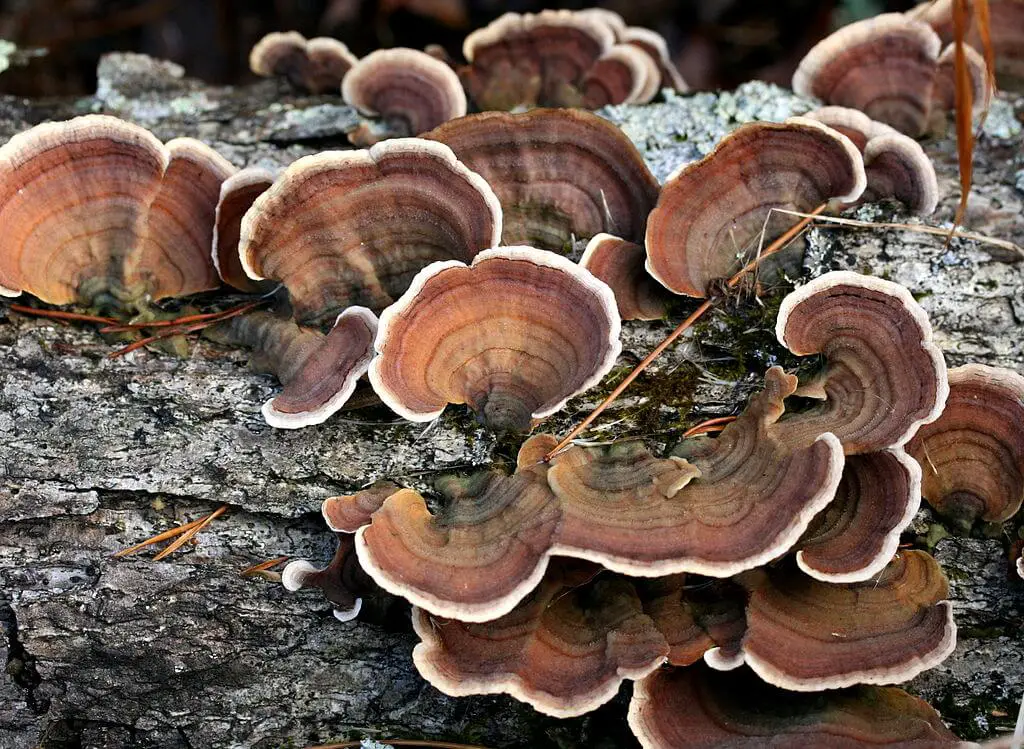

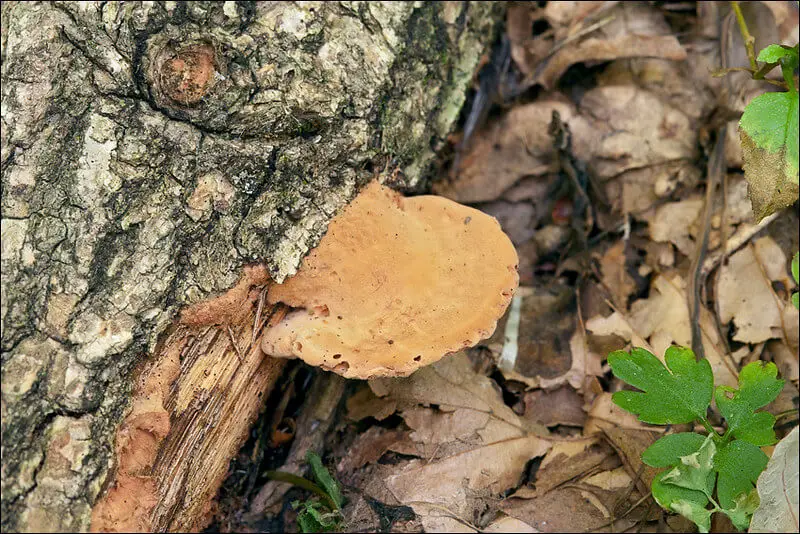
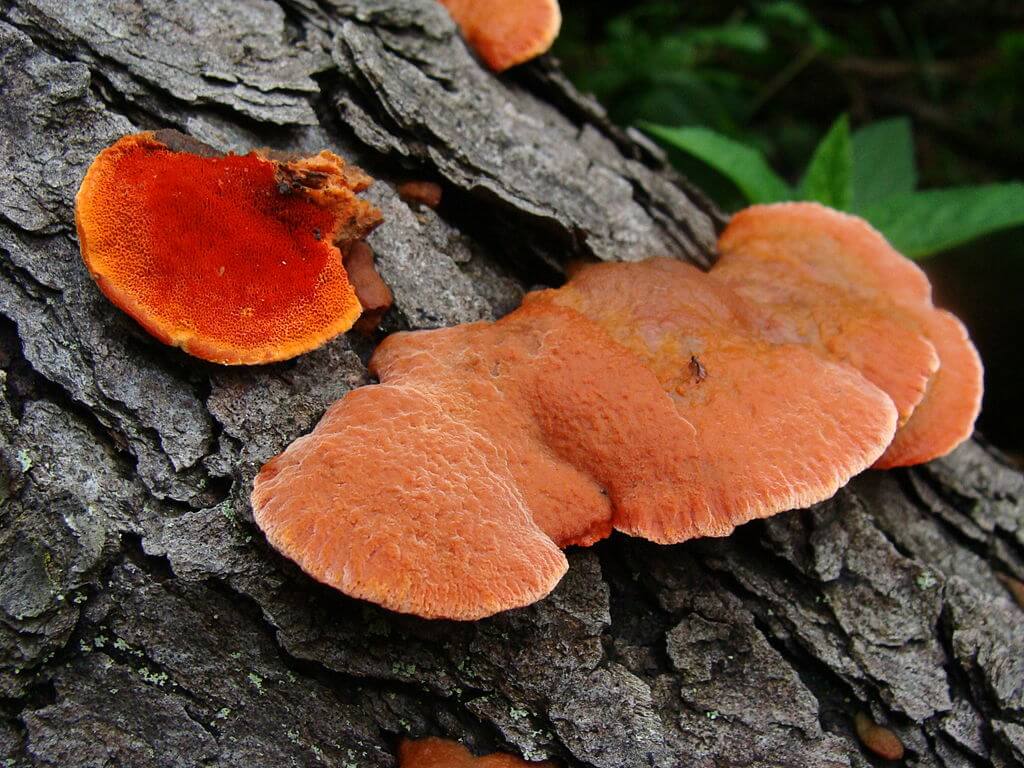
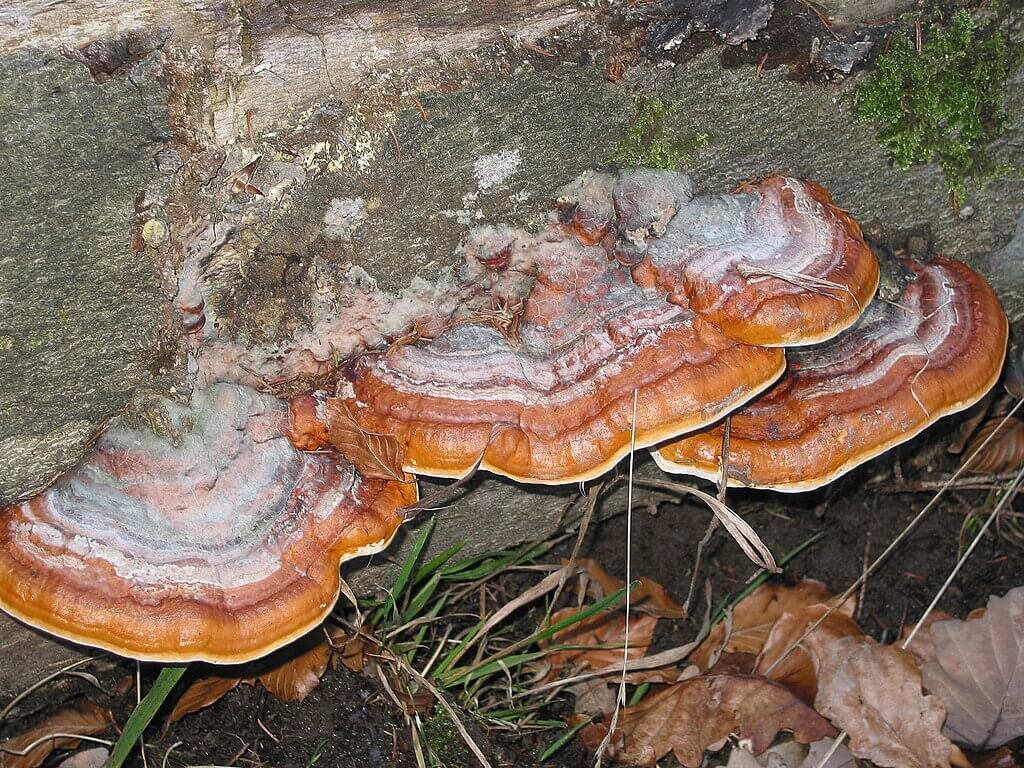
Cooking Beefsteak Mushrooms
When preparing beefsteak mushrooms, you can sauté, roast, or grill them. Some people enjoy them as a meat substitute in vegetarian dishes due to their texture and umami flavor.
Is beefsteak fungus a good substitute for beef?
While beefsteak fungus can be used in dishes as a meat substitute due to its texture, it should not be considered a direct replacement for beef in terms of taste.

How do you make beefsteak mushroom soup?
Here’s an easy recipe we tested out:
Ingredients:
- 1 pound (450g) beefsteak mushrooms, cleaned and sliced
- 1 onion, finely chopped
- 2 cloves garlic, minced
- 2-3 medium-sized potatoes, peeled and diced
- 4 cups vegetable or mushroom broth (homemade or store-bought)
- 1 cup heavy cream or a non-dairy alternative (e.g., coconut milk)
- 2 tablespoons butter or olive oil
- Salt and pepper, to taste
- Fresh herbs (e.g., thyme, parsley) for garnish (optional)
Instructions:
- Prepare the Mushrooms: Clean the beefsteak mushrooms thoroughly and slice them into thin strips or bite-sized pieces.
- Sauté the Vegetables: In a large soup pot or Dutch oven, heat the butter or olive oil over medium heat. Add the chopped onion and garlic, and sauté until they become translucent and fragrant.
- Add the Mushrooms: Add the sliced beefsteak mushrooms to the pot and cook for about 5-7 minutes, stirring occasionally, until they start to soften and release their moisture.
- Add Potatoes: Add the diced potatoes to the pot and continue to cook for another 2-3 minutes, allowing them to combine with the mushrooms and onions.
- Pour in the Broth: Pour in the vegetable or mushroom broth, and bring the mixture to a boil. Reduce the heat to a simmer and cover the pot. Let it simmer for about 20-25 minutes, or until the potatoes are tender.
- Blend the Soup: Use an immersion blender to puree the soup until smooth and creamy. Alternatively, you can transfer the soup in batches to a countertop blender, but be sure to allow it to cool slightly before blending to avoid splattering.
- Add Cream: Return the blended soup to the pot and stir in the heavy cream or non-dairy alternative. Heat the soup gently over low to medium heat, stirring occasionally, until it’s heated through. Do not let it boil after adding the cream.
- Season: Season the soup with salt and pepper to taste. Adjust the seasoning as needed.
What are the health benefits of beefsteak fungus?
Beefsteak fungus has been traditionally used in herbal medicine for various purposes, but its potential health benefits are not as extensively studied or documented as some other mushrooms.
However, it does contain several bioactive compounds and nutrients that may offer certain health benefits:
- Anti-Inflammatory Effects: Some studies suggest that beefsteak fungus may possess anti-inflammatory properties due to its bioactive compounds. Reducing inflammation is associated with various health benefits.
- Antibacterial and Antifungal Activity: Certain compounds in beefsteak fungus have demonstrated antibacterial and antifungal activity in laboratory studies.
- Digestive Health: In traditional herbal medicine, beefsteak fungus has been used to support digestive health. Some believe it may help with digestive issues, although scientific evidence is limited.
- Wound Healing: In traditional medicine, beefsteak fungus has been used topically for wound healing due to its potential antibacterial and anti-inflammatory properties.
What to read next: A forager’s Guide To Half Free Morels
Ana has always been interested in all things nature and flora. With her expertise in home gardening and interest in foraging, she has been spending her weekends and free time looking for edible native plants, flowers, and fungi. One of her many hobbies includes testing new savory and sweet recipes, juices or teas made from freshly picked plants, wild fruits, or mushrooms.

